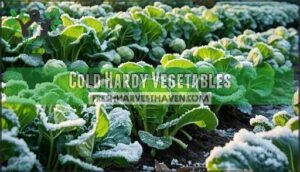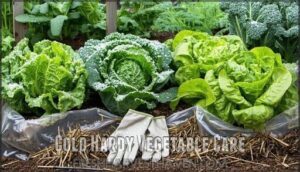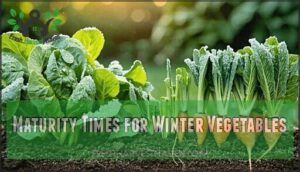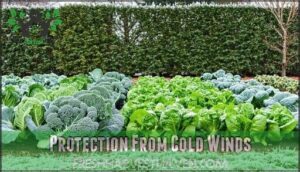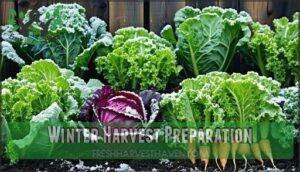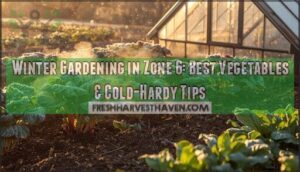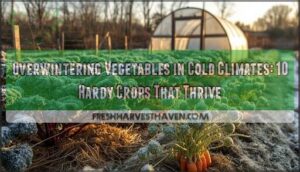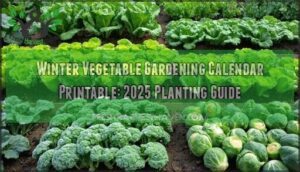This site is supported by our readers. We may earn a commission, at no cost to you, if you purchase through links.

These frost-resistant champions like kale, Brussels sprouts, carrots, and spinach can handle temperatures down to 10-20°F, with many actually becoming sweeter after a frost hits.
Plant them in late summer or early fall, giving them time to establish before winter’s grip tightens.
Use row covers and mulch for extra protection during harsh cold snaps.
The secret lies in choosing varieties bred for cold tolerance and timing your plantings just right for your growing zone.
Table Of Contents
- Key Takeaways
- Cold Hardy Vegetables
- Winter Gardening Timing
- Cold Hardy Vegetable Care
- Growing Cold Hardy Vegetables
- Winter Harvest Preparation
- Frequently Asked Questions (FAQs)
- Which is the frost tolerant crop?
- What vegetables do you harvest in the winter?
- Are there any vegetables that can be planted in October?
- What are the hearty winter vegetables?
- What are the most cold hardy winter vegetables?
- What is the lowest temperature vegetable plants can tolerate?
- What is the easiest winter veg to grow?
- When should I start my winter vegetable garden?
- What month to plant winter vegetables?
- What vegetables will not survive a frost?
- Conclusion
Key Takeaways
- You’ll get the best results by planting cold hardy vegetables like kale, spinach, carrots, and Brussels sprouts in late summer or early fall, giving them 6-12 weeks to establish before your first hard frost hits.
- Your winter vegetables actually become sweeter after frost exposure since cold temperatures convert starches into natural sugars, making carrots, parsnips, and kale taste better in winter than summer.
- You’ll need to protect your crops with row covers, mulch, and cold frames during harsh cold snaps, but many varieties can survive temperatures down to 0-20°F without damage.
- You can harvest fresh vegetables throughout winter by choosing the right varieties for your hardiness zone and timing your plantings correctly – some crops like spinach can be ready in just 35-45 days even in cold weather.
Cold Hardy Vegetables
Winter gardening doesn’t stop when temperatures drop below freezing. You can grow hardy vegetables that actually improve in flavor after experiencing frost, providing fresh produce throughout the coldest months.
Leafy Greens for Winter
Winter Spinach Varieties and other cold hardy greens become your garden’s heroes when temperatures drop.
Frost-Sweetened Greens like kale transform bitter compounds into natural sugars, creating delicious harvests.
Kale Nutritional Powerhouse varieties withstand brutal cold while Arugula Cold Hardiness surprises many gardeners.
Collard Green Cuisine reaches peak flavor after frost exposure.
These winter vegetables don’t just survive—they thrive, providing fresh nutrition when grocery store prices soar.
Root Vegetables for Winter
Root vegetables transform under winter’s harsh embrace, developing exceptional frost sweetness as cold temperatures convert starches into natural sugars.
You’ll discover that carrots, parsnips, beets, and turnips actually improve their flavor profiles when exposed to freezing conditions.
Carrots, parsnips, and turnips reach peak sweetness as frost kisses them, making winter the perfect time for flavorful harvests.
Cold hardiness varies by vegetable—carrots tolerate 15°F while parsnips withstand 0°F temperatures.
Soil density affects root development, so prepare loose, well-draining beds before planting.
These winter vegetables offer significant nutritional benefits, providing essential vitamins and minerals throughout cold months.
Winter storage becomes simple with proper mulching techniques that protect your root vegetables from freeze damage while maintaining harvest accessibility for your winter harvest.
Other Cold Hardy Varieties
Beyond root vegetables, you’ll find winter-hardy herbs like thyme and oregano that survive harsh conditions.
Perennial vegetables such as asparagus and rhubarb return yearly.
Cold-hardy legumes like Austrian winter peas fix nitrogen while growing.
Try unusual greens including claytonia and miner’s lettuce for variety.
Brussels sprouts and regional varieties of cabbage extend your winter vegetable gardening season.
These frost tolerant vegetables diversify your cold weather crops selection.
Winter Gardening Timing
Timing your winter vegetable plantings correctly determines whether you’ll harvest crisp greens in January or watch frozen seedlings turn to mush.
Success in winter gardening hinges on perfect timing—plant too late and your crops won’t survive.
You’ll need to count backward from your first expected frost date, giving each crop enough time to mature before temperatures drop below their tolerance levels.
Zone-Based Planting Schedules
Your growing zones determine which cold weather crops will survive winter’s bite.
Hardiness zones map minimum temperatures, while first frost dates set your planting windows for growing winter vegetables.
Regional variations and microclimates matter—a south-facing slope might buy you an extra zone of frost tolerance.
Smart winter garden planning means checking local extension guides and frost maps, then timing your sowings accordingly.
Importance of Early Planting
Timing makes or breaks your winter garden planning success. Start sowing late season vegetables between mid-August and early October to maximize yield before harsh weather arrives.
This head start allows proper root development and helps plants build frost hardiness naturally. Your overwintering vegetables need time to mature before temperatures drop substantially.
- Plant spinach 6-8 weeks before first expected frost
- Sow kale in late summer for sweetest winter harvest vegetables
- Start carrots early autumn to prevent bolting when spring returns
- Give beets 8-10 weeks to develop strong root systems
- Schedule turnips for mid-September planting in most zones
Early planting lets growing winter vegetables establish deep roots and thick leaves that resist cold damage. Consider mulching for protection after the first hard frost. Plants started too late won’t develop adequate frost protection mechanisms, which is crucial for a successful winter garden with a good yield and proper root development.
Weather Severity Considerations
Understanding your cold hardy vegetables‘ temperature tolerance means preparing for nature’s curveballs.
Frost impact varies dramatically across regional variations – what kills crops in Georgia might barely tickle plants in Maine.
Temperature fluctuations stress plants more than steady cold.
A warm spell followed by sudden freezing damages cell walls, while wind chill accelerates moisture loss and heat transfer.
Snow cover acts like nature’s blanket, insulating soil and protecting root systems from freezing temperatures.
Track your local weather patterns and microclimates.
South-facing walls reflect heat, while low-lying areas collect cold air like invisible lakes.
Here’s your weather defense strategy:
| Weather Factor | Benefit | Risk | Solution |
|---|---|---|---|
| Snow | Insulates soil | Prolonged thaw delays | Mulch for warmth |
| Rain | Waters plants | Root rot | Row covers |
| Ice | Seals moisture | Plant breakage | Stake for support |
| Frost | Kills sensitive crops | Damaged tissue | Cloches or covers |
Smart gardeners read weather like a roadmap, adjusting protection methods accordingly.
Cold Hardy Vegetable Care
Successfully growing cold hardy vegetables through winter requires proper protection and care techniques.
You’ll need to master mulching, row covers, and strategic harvesting methods to maximize your winter harvest and keep your crops thriving in harsh conditions, using techniques such as strategic harvesting.
Mulch and Frost Protection
Mulch Types like straw, shredded leaves, or wood chips create essential winter protection for your cold hardy vegetables.
These organic materials act as frost blankets, insulating roots and preventing soil temperature swings. Snow cover actually provides additional insulation, trapping warmth beneath.
Cold frames work perfectly with mulch layers for double protection. You can find various mulch options to suit your garden’s needs.
Proper mulching prevents frost damage while managing watering impact by retaining moisture and preventing soil freeze-thaw cycles that damage roots in your winter garden.
Row Covers for Winter Vegetables
Row covers provide your winter garden with reliable protection against frost, wind, and pests.
These lightweight fabrics create a microclimate that helps cold hardy crops survive the coldest temperatures while maintaining steady growth.
To find the right one, you can shop winter covers.
Cover Materials range from lightweight spun fabric to heavier frost blankets.
Installation Methods include floating directly on plants or supporting with hoops for taller vegetables.
Ventilation Needs require opening covers during warm days to prevent overheating.
Pest Control benefits come naturally as covers block insects from reaching your winter protection setup.
Choose covers based on your cold frame vegetables’ specific needs and local climate conditions.
Harvesting and Storage Methods
After protecting your crops with row covers, proper harvest timing becomes your next priority for maximizing winter vegetable quality.
Pick vegetables during dry weather when temperatures stay above freezing to prevent damage and extend shelf-life.
Master these winter harvest tips for maximum winter crop preservation:
- Root cellaring: Store carrots, beets, and turnips in cool, humid conditions at 32-39°F with 90% humidity for 3-5 months.
- In-ground storage: Leave root vegetables mulched in soil through winter, harvesting as needed for fresh taste.
- Cold storage curing: Dry onions and garlic 2-3 weeks before storing in ventilated areas at 39-46°F.
To help maintain freshness, consider using perforated plastic bags.
These winter crop storage methods guarantee your harvest stays fresh throughout the coldest months.
Growing Cold Hardy Vegetables
You’ll need to provide the right growing conditions to guarantee your cold-hardy vegetables reach maturity before winter’s harsh conditions arrive.
Most winter vegetables require full sun exposure and well-draining soil, with specific timing windows that vary by hardiness zone and expected frost dates.
Soil and Sun Requirements
Your cold hardy vegetables need well-drained soil with proper soil drainage to prevent root rot during wet winter months.
Most winter crops thrive in loamy soil enriched with compost, though sandy soil works if you add organic matter.
Maintain soil pH between 6.0 and 7.0 for ideal nutrient needs.
Choose locations with full sun exposure, aiming for six hours of winter sunlight daily.
Nutrient-rich soil combined with adequate sun exposure creates the foundation for successful winter harvests.
Maturity Times for Winter Vegetables
Timing your winter vegetables correctly makes the difference between a successful harvest and disappointment. Growth duration extends substantially as daylight hours shrink and temperatures drop, often doubling standard harvest times. Variety selection becomes critical for winter garden harvest success.
Mature plants develop different timing patterns:
- Fast-growing greens like spinach reach harvest in 35-45 days, while arugula provides baby leaves at 25-30 days
- Root vegetables including carrots and beets need 60-80 days, with frost impact actually improving sweetness
- Long-season crops such as parsnips require 120-150 days but reward patience with superior winter vegetables flavor
Calculate your planting window by adding 50-100% extra time to seed packet recommendations for optimal harvest of coldhardy vegetables. To achieve an October harvest, remember to start seeds early.
Protection From Cold Winds
Despite harsh conditions, your winter garden vegetables need strategic wind blocking to thrive. Strong gusts create damaging microclimates that stress cold-hardy vegetables and reduce yields.
Position windbreak materials like fences or evergreen hedges on the windward side of your garden. Consider various garden wind barrier options to find the best solution.
Adjust plant spacing to create natural wind barriers—clustering frost-hardy crops together provides mutual protection. Garden orientation matters too; observe prevailing wind patterns before planting cold-weather crops.
wind damage
plant protection
These protective measures guarantee your winter crop protection strategy succeeds throughout the growing season.
Winter Harvest Preparation
You’ll need to prepare your winter vegetables for the harsh months ahead by understanding their specific growing needs and storage requirements.
Proper preparation guarantees continuous harvests even when temperatures drop below freezing, giving you fresh produce throughout winter.
Vegetable-Specific Growing Conditions
Everyone benefits when matching vegetables to their ideal growing conditions. You’ll want soil pH between 6.0-7.0 for most cold-hardy crops, though lettuce tolerates slightly acidic conditions.
Kale and spinach need consistent watering practices without waterlogged soil. Sunlight needs vary—cabbage requires six hours daily while Swiss chard tolerates partial shade. Nutrient requirements differ too: leafy greens crave nitrogen-rich soil.
Your growing season extends with proper pest control and mulching strategies.
- Carrot Growing: Needs loose, deep soil
- Spinach: Tolerates light frost
- Turnip Field: Prefers moisture-retaining soil
- Leeks: Thrive shielded from winds
- Rutabagas: Favor cooler, shaded zones
Fall Gardening Tips and Tricks
Successful autumn planting starts with smart Soil Preparation—add compost now to feed your winter vegetable crops through cold months.
Your Seed Selection matters too; choose frostresistant varieties that’ll handle temperature drops without missing a beat.
Pest Control becomes your ace in the hole since bugs don’t vanish with the first frost. Apply organic treatments before they settle in for winter.
Watering Techniques need adjustment—soggy soil kills more coldhardy vegetables than frost does.
Don’t forget Tool Maintenance either. Sharp, oiled tools make winter gardening tasks easier when your hands are cold and daylight’s short.
Soil Preparation
Pest Control
Tool Maintenance
Frost Protection
Overwintering and Storage Tips
Maximizing your winter harvest requires strategic overwintering and proper storage techniques. Root cellaring provides long-term storage for winter keepers like carrots and beets.
Here are six essential winter gardening tips:
- Apply proper insulation with 4-6 inches of mulch around cold hardy vegetables
- Install cold frames for extended growing seasons and protection
- Practice pest control by removing diseased plant material before winter
- Master root cellaring techniques for storing beets, turnips, and parsnips
- Plan seed saving from your healthiest overwintered plants
- Monitor soil moisture levels throughout winter storage periods
To maintain freshness, consider optimal storage environments for your produce.
Frequently Asked Questions (FAQs)
Which is the frost tolerant crop?
Several crops show frost tolerance, but kale stands out as the champion.
You’ll find varieties like ‘Winterbor’ surviving temperatures down to -10°F while actually becoming sweeter after frost hits your garden.
What vegetables do you harvest in the winter?
Looking for fresh produce when snow blankets your garden?
You’ll harvest cold-hardy vegetables like kale, spinach, carrots, beets, and parsnips that actually sweeten with frost exposure and thrive in winter temperatures.
Are there any vegetables that can be planted in October?
You can plant several cold-hardy vegetables in October for winter harvest.
Spinach, kale, and arugula establish well before frost arrives.
Root vegetables like radishes and turnips also thrive when planted in autumn’s cooler temperatures, which allows them to thrive.
What are the hearty winter vegetables?
While summer gardens wither and die, hardy winter vegetables thrive in freezing temperatures. You’ll find kale, spinach, carrots, and turnips actually sweeten after frost, providing fresh harvests through snow.
What are the most cold hardy winter vegetables?
Kale, spinach, and parsnips top the cold-hardiness charts, surviving temperatures down to -10°F, 0°F, and 0°F respectively. These winter warriors actually sweeten after frost exposure.
What is the lowest temperature vegetable plants can tolerate?
Most vegetables won’t survive extreme cold, but surprisingly hardy varieties like kale can endure temperatures down to -10°F, while spinach tolerates 0°F and parsnips withstand frozen ground conditions.
What is the easiest winter veg to grow?
Spinach takes the crown for beginner-friendly winter growing. It’ll bounce back from frost, matures in just thirty days, and you can harvest leaves continuously without killing the plant.
When should I start my winter vegetable garden?
Start planting in late summer, around 10-12 weeks before your first hard frost. This timing lets cold-hardy crops mature before winter’s bite hits hardest.
What month to plant winter vegetables?
Timing is everything in gardening – plant your winter vegetables in late summer through early fall.
You’ll want to sow seeds from August through October, depending on your location and first frost date.
What vegetables will not survive a frost?
Tender vegetables like tomatoes, peppers, eggplants, basil, cucumbers, and beans can’t handle frost. These warm-season crops die when temperatures drop below 32°F, turning black and mushy overnight.
Conclusion
Growing cold hardy vegetables for winter harvest transforms your garden from a seasonal hobby into a year-round food source.
You’ll discover that proper timing, variety selection, and protection methods guarantee fresh produce even when snow blankets the ground.
These frost-resistant crops offer superior nutrition and flavor during winter months.
With careful planning and basic protection techniques, you’ll enjoy homegrown vegetables throughout the coldest season while reducing grocery expenses substantially.

